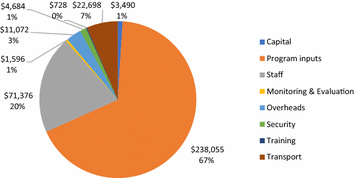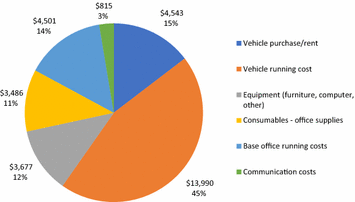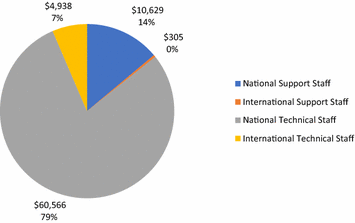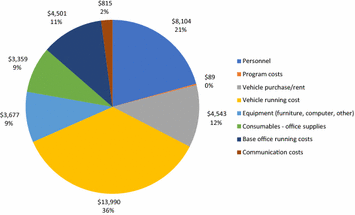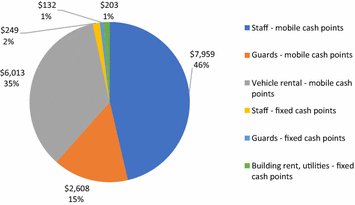Costs and cost-efficiency of a mobile cash transfer to prevent child undernutrition during the lean season in Burkina Faso: a mixed methods analysis from the MAM'Out randomized controlled trial
- PMID: 29686539
- PMCID: PMC5899398
- DOI: 10.1186/s12962-018-0096-9
Costs and cost-efficiency of a mobile cash transfer to prevent child undernutrition during the lean season in Burkina Faso: a mixed methods analysis from the MAM'Out randomized controlled trial
Abstract
Background: This study assessed the costs and cost-efficiency of a mobile cash transfer implemented in Tapoa Province, Burkina Faso in the MAM'Out randomized controlled trial from June 2013 to December 2014, using mixed methods and taking a societal perspective by including costs to implementing partners and beneficiary households.
Methods: Data were collected via interviews with implementing staff from the humanitarian agency and the private partner delivering the mobile money, focus group discussions with beneficiaries, and review of accounting databases. Costs were analyzed by input category and activity-based cost centers. cost-efficiency was analyzed by cost-transfer ratios (CTR) and cost per beneficiary. Qualitative analysis was conducted to identify themes related to implementing electronic cash transfers, and barriers to efficient implementation.
Results: The CTR was 0.82 from a societal perspective, within the same range as other humanitarian transfer programs; however the intervention did not achieve the same degree of cost-efficiency as other mobile transfer programs specifically. Challenges in coordination between humanitarian and private partners resulted in long wait times for beneficiaries, particularly in the first year of implementation. Sensitivity analyses indicated a potential 6% reduction in CTR through reducing beneficiary wait time by one-half. Actors reported that coordination challenges improved during the project, therefore inefficiencies likely would be resolved, and cost-efficiency improved, as the program passed the pilot phase.
Conclusions: Despite the time required to establish trusting relationships among actors, and to set up a network of cash points in remote areas, this analysis showed that mobile transfers hold promise as a cost-efficient method of delivering cash in this setting. Implementation by local government would likely reduce costs greatly compared to those found in this study context, and improve cost-efficiency especially by subsidizing expansion of mobile money network coverage and increasing cash distribution points in remote areas which are unprofitable for private partners.
Figures
Similar articles
-
The MAM'Out project: a randomized controlled trial to assess multiannual and seasonal cash transfers for the prevention of acute malnutrition in children under 36 months in Burkina Faso.BMC Public Health. 2015 Aug 8;15:762. doi: 10.1186/s12889-015-2060-3. BMC Public Health. 2015. PMID: 26253152 Free PMC article. Clinical Trial.
-
Beneficiaries' perceptions and reported use of unconditional cash transfers intended to prevent acute malnutrition in children in poor rural communities in Burkina Faso: qualitative results from the MAM'Out randomized controlled trial.BMC Public Health. 2017 May 30;17(1):527. doi: 10.1186/s12889-017-4453-y. BMC Public Health. 2017. PMID: 28558709 Free PMC article. Clinical Trial.
-
Unconditional Cash Transfers Do Not Prevent Children's Undernutrition in the Moderate Acute Malnutrition Out (MAM'Out) Cluster-Randomized Controlled Trial in Rural Burkina Faso.J Nutr. 2017 Jul;147(7):1410-1417. doi: 10.3945/jn.117.247858. Epub 2017 May 24. J Nutr. 2017. PMID: 28539413 Clinical Trial.
-
Impact of conditional and unconditional cash transfers on health outcomes and use of health services in humanitarian settings: a mixed-methods systematic review.BMJ Glob Health. 2022 Jan;7(1):e007902. doi: 10.1136/bmjgh-2021-007902. BMJ Glob Health. 2022. PMID: 35078813 Free PMC article.
-
Cash transfers for HIV prevention: A systematic review.PLoS Med. 2021 Nov 29;18(11):e1003866. doi: 10.1371/journal.pmed.1003866. eCollection 2021 Nov. PLoS Med. 2021. PMID: 34843468 Free PMC article.
Cited by
-
Experiences of conditional and unconditional cash transfers intended for improving health outcomes and health service use: a qualitative evidence synthesis.Cochrane Database Syst Rev. 2023 Mar 31;3(3):CD013635. doi: 10.1002/14651858.CD013635.pub2. Cochrane Database Syst Rev. 2023. PMID: 36999604 Free PMC article. Review.
-
Effectiveness of conditional cash transfers, subsidized child care and life skills training on adolescent mothers' schooling, sexual and reproductive health, and mental health outcomes in Burkina Faso and Malawi: the PROMOTE Project pilot randomized controlled trial protocol.Reprod Health. 2023 Nov 9;20(1):166. doi: 10.1186/s12978-023-01706-9. Reprod Health. 2023. PMID: 37946289 Free PMC article.
-
Economic evaluation of a conditional cash transfer to retain women in the continuum of care during pregnancy, birth and the postnatal period in Kenya.PLOS Glob Public Health. 2022 Mar 7;2(3):e0000128. doi: 10.1371/journal.pgph.0000128. eCollection 2022. PLOS Glob Public Health. 2022. PMID: 36962294 Free PMC article.
References
-
- Glassman A, Duran D, Fleisher L, Singer D, Sturke R, Angeles G, Charles J, Emrey B, Gleason J, Mwebsa W, Saldana K. Impact of conditional cash transfers on maternal and newborn health. J Health Popul Nutr. 2013;31(4 Suppl 2):S48. - PubMed
-
- Grellety E, Babakazo P, Bangana A, Mwamba G, Lezama I, Zagre NM, Ategbo EA. Effects of unconditional cash transfers on the outcome of treatment for severe acute malnutrition (SAM): a cluster-randomised trial in the Democratic Republic of the Congo. BMC Med. 2017;15(1):87. doi: 10.1186/s12916-017-0848-y. - DOI - PMC - PubMed
-
- Gaarder MM, Glassman A, Todd JE. Conditional cash transfers and health: unpacking the causal chain. J Dev Eff. 2010;2(1):6–50. doi: 10.1080/19439341003646188. - DOI
-
- Manley J, Gitter S, Slavchevska V. How effective are cash transfer programmes at improving nutritional status? A rapid evidence assessment of programmes’ effects on anthropometric outcomes. London: EPPI-Centre, Social Research Science Unit, Institute of Education, University of London; 2012.
-
- Buston O, Smith K. Global humanitarian assistance report 2013. Bristol: Global Humanitarian Assistance; 2013.
LinkOut - more resources
Full Text Sources
Other Literature Sources

